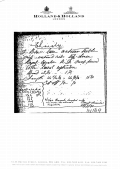Holland & Holland, 98 New Bond Street,
London
12 bore 'Royal' Bar Action, Sidelock Ejector
no. 14169
Date of manufacture: 1891
Click on these images for more detail.
|
Heritage Guns' Comment This is a very fine example of Holland & Holland's
'flag ship' gun from the last quarter of the 19th Century and
is in unusually good and original condition for its age. As with
so many older guns, the Damascus barrels had been soft solder
sleeved by Westley Richards in 1970 and we have recently re-sleeved
the gun using the so-called 'Invisible Sleeving' TIG welding method
and re-proofed it for 2 3/4" cartridges. WE REGRET THAT THIS GUN IS NOW SOLD. IF YOU ARE SEARCHING FOR A SIMILAR GUN, PLEASE CONTACT US.
|
The action is of combined Rogers
and Scott design and features:
Double triggers bolted by an automatic top tang
safety slide,
Bar action locks,
Roger's cocking levers,
Breech face 'Gas Checks',
'Patent Safety Lock' Interceptor Sears,
Top lever operating a 'Purdey Bolt' by way of a 'Scott Spindle',
Top rib extension providing a 3rd bite,
Holland & Robertson's patent ejector and split extractors,
and Anson's push rod forend catch.
Gun weight 6lb 13 1/2oz
Engraving style Best Bouquet & Fine Scroll. Carved fences with
bold acanthus leaf design. Gold inlaid '2' to top lever and barrel rib,
engraved '2' to forend iron and trigger guard.
Trigger pulls measure approximately: Front trigger 3 1/2lbs Rear
trigger 4 1/2lbs
The Damascus to Steel TIG sleeved barrels
are 28" in length, chambered for 2 3/4" (70mm) cartridges
and are of brazed 'dovetail' lump construction with soft soldered ribs.
Top rib is of the smooth, concave game type.
London reproof for 70mm nitro powder cartridges in 2009.
Approximate barrel measurements at date of publication:
|
Nominal Proof Size
|
Bore Diameter 9" from Breech
|
Minimum Wall Thickness
|
Choke Constriction
|
|
| Right Barrel |
18.6mm (0.732")
|
0.732"
|
0.031" Minimum
|
0.010" (1/4)
|
| Left Barrel |
18.7mm (0.736")
|
0.737"
|
0.027" Minimum
|
0.020" (1/2)
|
Straight Hand Stock and Splinter Forend are crafted from highly figured walnut. We believe that the stock and forend wood is the original, judging from its quality and similarity to the original specification in the maker's records. There are two very fine 'settling' cracks, one behind each lock, and a repair inlet to the forend wood edge.
The 22 lines per inch chequering
is to normal sidelock pattern. The stock is lightly cast off for a right-handed
shot and if fitted with a 3/4" leather covered recoil pad and carries
a blank oval.
The stock is finished with a traditional linseed oil based preparation
as used on best guns by one of the top English makers. This finish uses
no grain fillers to achieve its deep, smooth lustre, only many hours
of alternate build and flatting off of the surface.
Approximate stock measurements at date of publication:
|
Pull to Heel
|
Pull to Bump
|
Pull to Centre
|
Pull to Toe
|
|
14 7/8"
|
14 7/8"
|
15"
|
15 1/2"
|
|
Drop at Comb
|
Drop at Face
|
Drop at Heel
|
|
1 11/16"
|
1 15/16"
|
2 5/8"
|
|
Cast at Comb
|
Cast at Heel
|
|
Negligible
|
1/8" (approximate)
|
For the purposes of these measurements,
'Drop at Face' is the 'drop' measurement taken on a line perpendicular
to the
line joining the trigger and centre of the butt at approximately 8"
from the trigger (front trigger on a double trigger gun).
Patents Exhibited include:
Scott's gas check patent no. 617 of 1882,
Holland & Robertson's interceptor sears patent
no. 5834 of 1887,
Holland & Robertson's ejector patent no. 11623 of 1887,
'Purdey Bolt' patent no. 1104 of 1863,
'Scott Spindle' patent no. 2752 of 1865,
Scott's top extension patent no. 1902 of 1875,
Anson's forend fastener patent no. 3791 of 1872.







